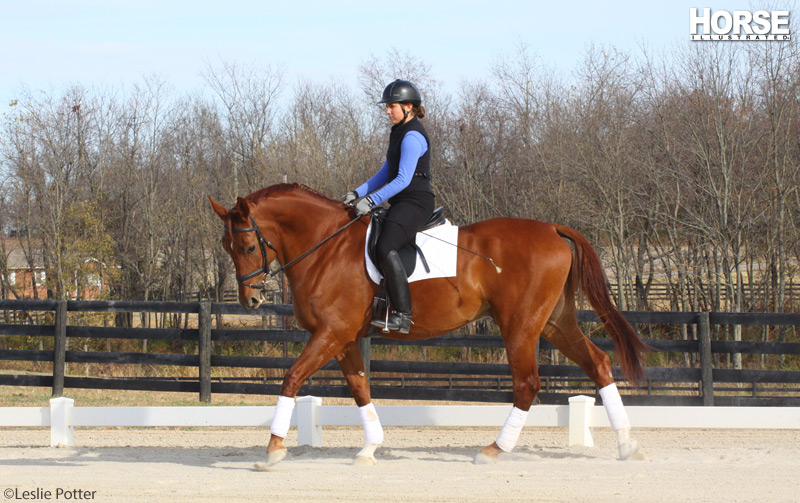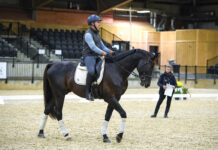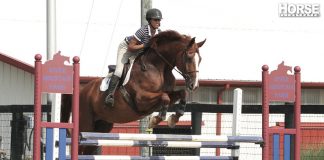No horse is born able to understand and perfectly respond to a rider’s aids. Whether through bad habits, physical make-up or a lack of training, horses can end up with less-than-ideal habits under saddle. Here, Grand Prix dressage rider and trainer Reese Koffler-Stanfield offers tips and exercises for correcting some common problems.

The Horse that Won’t Slow Down
Many riders are familiar with the hot horse that just wants to “go,” and blows off your requests to slow down.
Koffler-Stanfield recommends practicing a lot of transitions. “I like to start with walk to halt, progressing to trot to halt,” she says. “If it’s hard to get a transition on a big circle or the long side, try it on a smaller circle until your horse is listening to your aids more.”
Koffler-Stanfield says that this problem is common among horses in any English discipline—eventers, hunter/jumpers and dressage horses can all be found with insufficient brakes. “The transitions really get your horse listening to your seat,” she says. “You have to get him to listen so he quickly comes back when you give a light aid, which is the key here. For horses that are really strong, it’s hard to go the whole long side of the arena and then ask for a halt, so I like to go from trotting a smaller circle to a halt, or do a walk transition toward the rail to help the horse come back. Ideally, you want to get the transition just from your seat, without a lot of hand; you want to avoid doing a lawnmower pull. The more transitions you do correctly, the easier it’s going to be.”
Koffler-Stanfield also notes an important point for competitive dressage riders: “When you’re riding transitions, you’re always riding them for the perfect 10-point score. During the test—no matter what level—every transition has its own score. So it’s important to use those transitions to get your horse respecting your half-halts and your aids.”
The Horse that Won’t Go Forward
Of course, some horses have the opposite problem: You have to constantly kick them along to get forward movement, and they come grinding to a halt if you stop using your legs.
“This is very common for a horse that is behind the aids,” says Koffler-Stanfield. “I start at the halt and put my leg on the horse. If he doesn’t go forward from a light aid, I will correct him with a strong leg aid. If he doesn’t respond to my stronger leg aid, then I will use the whip to correct him again.
“When you get the desired response, you must praise your horse and then ask him to respond to your aids again, using the same systematic approach.” This way, your horse will learn that if he listens to your light nudge, he won’t get the sharp correction that comes from ignoring it.
Once again, transitions come in handy to sharpen your horse’s response to your aids, but this time they are upward instead of downward. Koffler-Stanfield recommends halt to walk or halt to trot, but don’t punish your horse if he breaks into the canter. “That’s the worst thing you can do,” she says. “If your horse canters, calmly bring him back to the trot and praise him for going forward.”
The Stiff Horse
Some horses can make you feel like you’re riding a 2-by-4 because they’re “stiff as a board.” Similar to people who are less naturally flexible, stretching and strengthening can be helpful for these horses.
“Think yoga for horses,” says Koffler-Stanfield. “Every horse is stiff in some way. I like to use a lot of serpentine loops, both large and small; circles; teardrop loops; and counter-canter if the horse has enough education. I also want to make sure that I do enough walk work before schooling to give my horse time to loosen his muscles and joints. Some people go into the work phase without giving their horse the proper amount of time to warm up.”
Four-loop Serpentine
A basic exercise Koffler-Stanfield offers to limber up your horse is to ride a four-loop serpentine at one end of the arena from one long side to the other. Go from the rail to the quarter line to the centerline, to the opposite quarter line, et cetera, all at the walk (Figure 1). “It’s a great warm-up exercise for any horse; for the older horse, it’s a great exercise to loosen him up,” says Koffler-Stanfield. She also likes to hack her horses out on a loop around the farm before coming into the ring, and do a lot of bending work before beginning the more intense portion of the ride.
“With horses that won’t bend, you have to be careful not to hang too much on the outside rein—think about softening it a little,” says Koffler-Stanfield. “If you’re holding it too tightly, it can block the horse. But always think ‘inside leg to outside rein.’ In this case, your inside rein just acts as a suppler.”
If you’re riding on a 20-meter circle, push your horse from your inside leg into your outside rein to get him more flexible in his ribcage. If he leans on the outside rein, bend him around your inside leg and supple him with your inside hand by squeezing and releasing. Always be sure to work equally in both directions.
Leg yield
The leg yield is one of the most basic lateral exercises and works wonders to loosen up horses of any level. Your horse should go forward and sideways in approximately equal measures, while keeping his body parallel to the long sides of the arena, although the forehand should be slightly in advance of the hindquarters. The aids for the leg yield can be confusing, however, so you’ll need to be clear with your horse to get him crossing his legs and suppling his back.
“If you’re leg yielding from left to right, your weight should be a little bit more in your right seatbone, while your right leg is in a neutral position gently resting on your horse’s side,” says Koffler-Stanfield. “Your left leg should be at the girth, pushing your horse to the right rein, while suppling him with the left rein.”
Teardrop
Another helpful exercise to loosen up a stiff horse is the teardrop loop.
“Begin by trotting down the long side, then at E, ride a teardrop loop to change directions, returning to the rail at H,” says Koffler-Stanfield (Figure 2). “The teardrop can be an 8- or 10-meter radius—whatever your horse is capable of. Sometimes people start riding circles and more circles, but I think it’s important to get off the circle from time to time.”
You can change up the teardrop by leg-yielding back to the rail, or by starting it in true canter and ending in counter-canter if your horse is more advanced. “It’s just another way of getting a horse to be more laterally supple,” adds Koffler-Stanfield.
The Overly Flexible Horse
The opposite problem of a stiff horse is the overly flexible horse that bends his neck too far to the inside and throws his shoulder out when you apply pressure to the inside rein. “This particular problem needs to be corrected with more outside rein connection,” says Koffler-Stanfield. “The important thing is working on straightness using your outside rein and leg. If your horse pops out his shoulder, try moving his shoulders to the inside with your outside rein and leg. Also, riding a correct leg-yield can be very helpful; if your horse starts to pop his shoulder out, then ride him straight for one or two strides to help correct the problem.”
Koffler-Stanfield says that using too much inside rein is a common fault among riders, particularly when circling and leg-yielding. You can also try riding in counter-flexion to get a feel for better connection on your outside rein.
Another exercise she suggests is “turning the shoulders,” as opposed to focusing on turning the head and neck. “Shift your horse’s shoulders to the left [by moving both hands to the left as a unit], and sit lightly on your inside seatbone. Think about moving his shoulders with your own shoulders and hips. If you look down quickly, your horse’s shoulders shouldn’t be popping out to the outside of the circle’s arc. Try it at the walk first, then at the trot. This exercise will help you stop pulling on the inside rein and get a little more control of the outside rein.”
The Horse that Curls Behind the Bit
Some horses avoid correct contact by pulling their head behind the vertical, usually a result of improper training in the past. “This can be a tough problem to fix,” says Koffler-Stanfield. “This type of horse would rather be behind your aids and not connected from behind (the hind legs) to your hand (the contact). Quick transitions can really help the problem by getting the horse to sit down on his hindquarters and pick up his shoulders.”
The Horse with a Fussy Head or Mouth
A fussy head or mouth is another one of the toughest problems to solve. Koffler-Stanfield recommends starting with a physical examination. “I always have my vet check the horse out first to make sure there are no health problems,” she says. “Next, I might try changing the horse’s bit. You must also keep a steady contact with your horse. Make sure your arms and hands aren’t stiff and hitting him in the mouth.”
The Horse that Won’t Accept Contact
A horse that won’t accept contact is also a problem commonly generated by the rider. “I always check the rider’s position and comfort level,” says Koffler-Stanfield. “If the rider isn’t steady with her body, it can be difficult to establish a constant contact with the horse. I want to see a rider’s contact look as steady as side reins, especially with a fussy horse. When your horse’s head goes up, increase pressure starting at your elbow until he relaxes his neck.
“Another way to think about contact is holding hands with a small child. If the child is walking next to you quietly, you will have soft contact with her hand. If the child runs or pulls away from your hand you will quickly increase the pressure to gain her attention, and then quickly soften it. The same principle applies to horses.”
With persistence and a systematic approach, almost any horse can improve with some simple dressage work. If your horse needs help in any of these areas, it’s also a good idea to get assistance from an experienced instructor.
Special thanks to Ellen Wall and Tvauri, a 10-year-old Dutch Warmblood, for demonstrating these exercises. In 2009, Ellen was 12th individually and earned team silver at the North American Young Rider and Junior Championships.
Liked this article? Here are more dressage exercises to try:
Dressage Arena Exercises
The Dressage Challenge
Video: Four Exercises to Master the Halt
Meet the Expert
Reese Koffler-Stanfield, a United States Dressage Federation (USDF) bronze, silver and gold medalist, is a nationally and internationally ranked professional High Performance competitor. She is a USDF Certified Instructor/Trainer through Fourth Level. www.maplecrestfarmky.com
Horse Illustrated Managing Editor Holly Werner Caccamise is constantly aspiring to improve her dressage riding.
This article originally appeared in the May 2011 issue of Horse Illustrated. Click here to subscribe.







j
Wow, tips for everything. Thanks!
lot of great tips!
My mare is 12, (just got her) and she likes to ring her tail, toss her head, (even with a hackamore or halter), walk sideways, turn sharp without be asked, and she what else she can get away with.